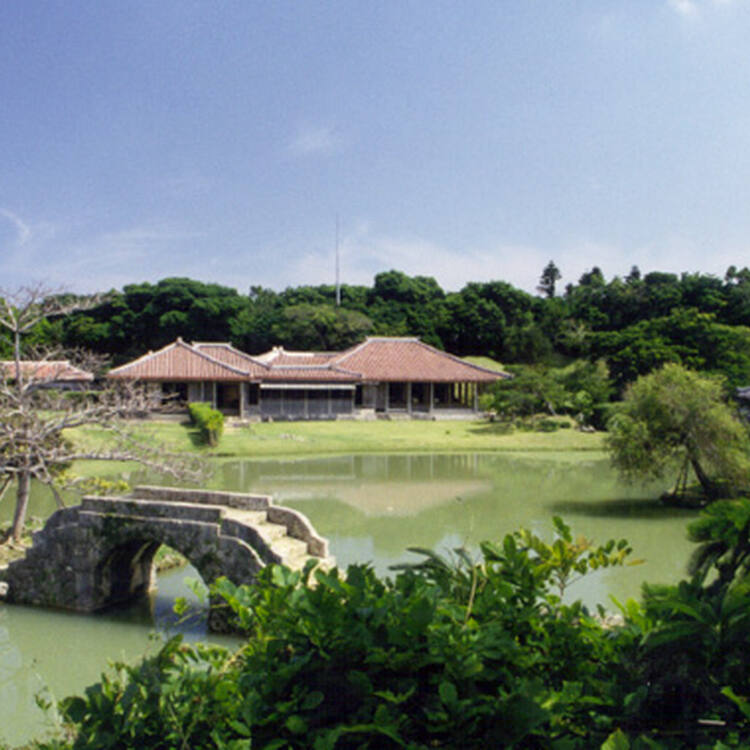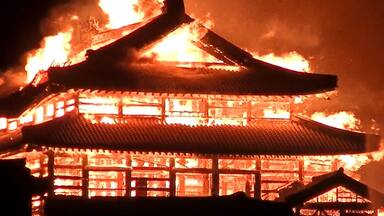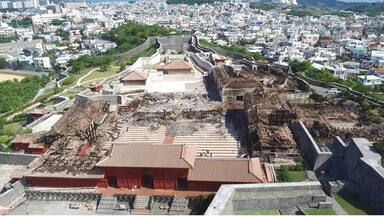Gusuku Sites and Related Properties of the Kingdom of Ryukyu
Gusuku Sites and Related Properties of the Kingdom of Ryukyu
Five hundred years of Ryukyuan history (12th-17th century) are represented by this group of sites and monuments. The ruins of the castles, on imposing elevated sites, are evidence for the social structure over much of that period, while the sacred sites provide mute testimony to the rare survival of an ancient form of religion into the modern age. The wide- ranging economic and cultural contacts of the Ryukyu Islands over that period gave rise to a unique culture.
Description is available under license CC-BY-SA IGO 3.0
Sites Gusuku et biens associés du royaume des Ryukyu
Ce groupe de sites et de monuments représente cinq cents ans d'histoire des Ryukyu (XIIe -XVIIe siècle). Les châteaux en ruine, qui se dressent sur d'imposantes hauteurs, illustrent la structure sociale d'une grande partie de cette période, tandis que les sites sacrés demeurent les témoins muets de la rare survivance d'une ancienne forme de religion jusque dans l'ère contemporaine. Les multiples contacts économiques et culturels des îles Ryukyu au cours de cette période s'expriment dans le caractère unique de la culture qu'elles ont forgée.
Description is available under license CC-BY-SA IGO 3.0
مواقع غوسوكو وممتلكات مملكة الريوكيو
تشكّل هذه المجموعة من المواقع والنصب 500 سنة من تاريخ الريوكيو (من القرن الثاني عشر حتى القرن السابع عشر). فالقصور المُهدَّمة المُنتصبة على مرتفعاتٍ عاليةٍ، تُبيّن التكوين الاجتماعي لفئةٍ كبيرةٍ من الذين عاشوا في تلك الحقبة. أما في ما يتعلّق بالمواقع المُقدّسة فهي لا تزال الشاهدة الصامتة على البقاء النادر للشكل القديم للديانة حتى التاريخ المُعاصر. وعلاقات جزر الريوكيو الاقتصاديّة والثقافيّة المُتعددّة في تلك الفترة تَظهر في الطابع الفريد للثقافة التي أنشأوها.
source: UNESCO/CPE
Description is available under license CC-BY-SA IGO 3.0
琉球王国时期的遗迹
该遗址群和建筑群展示了琉球王国500多年的历史(公元12世纪至17世纪),雄伟的城堡遗址体现了那个时期琉球王国的社会结构,而岛上的宗教圣地则无言地述说着古代宗教形式到现代少有的延续。在那500年中,琉球群岛王国广泛地与外界进行着经济和文化交流,从而造就了这一独特的文化遗存。
source: UNESCO/CPE
Description is available under license CC-BY-SA IGO 3.0
Замки «гусуку» и связанные с ними памятники древнего царства на островах Рюкю
500 лет истории Рюкю (XII-XVII вв.) представлены этой группой почитаемых мест и памятников. Руины замков, расположенные на возвышенных участках, отражают особенности социальной структуры того периода. Священные места, дошедшие до наших дней, представляют собой молчаливое свидетельство редкой древней формы религии. Широкие экономические и культурные контакты островов Рюкю послужили основой для развития уникальной культуры.
source: UNESCO/CPE
Description is available under license CC-BY-SA IGO 3.0
Sitios Gusuku y bienes culturales asociados del Reino de las Ryukyu
Este conjunto de sitios y monumentos es representativo de la historia de las islas Ryukyu entre los siglos XII y XVII. Los castillos en ruina, encaramados en cimas imponentes, ilustran la estructura social de una gran parte de esa época, mientras que los sitios sagrados son testigos mudos de la rara supervivencia de un antiguo culto religioso en la edad moderna. Los múltiples contactos económicos y culturales de las islas durante esos cinco siglos dieron origen a una cultura única en su género.
source: UNESCO/CPE
Description is available under license CC-BY-SA IGO 3.0
琉球王国のグスク及び関連遺産群
統一を達成し、中国、韓国、東南アジアと日本との仲介貿易で大きな役割を演じた14世紀後半から18世紀末の間の、琉球王国の特徴を表す文化遺産群。グスクと呼ばれる城塞建築が集中する沖縄本島中部を中心に、国頭から島尻にかけての次の9遺産が登録された。今帰仁城跡、座喜味城跡、勝連城跡、中城城跡、首里城跡、園比屋武御嶽石門、玉陵、識名園、斎場御嶽で、重要文化財2棟、史跡7、特別名勝1が含まれている。source: NFUAJ
Gusuku en aan het Koninkrijk van Ryukyu gerelateerde eigendommen
Deze gebieden en monumenten vertegenwoordigen vijfhonderd jaar geschiedenis van het koninkrijk van Ryukyu (12e-17e eeuw). De ruïnes van de kastelen – die op imposante, verhoogde plaatsen liggen – zijn het bewijs van de sociale structuur die tijdens een groot deel van deze periode heerste. De heilige plaatsen zijn stille getuigen van het zeldzame voortbestaan van een eeuwenoude vorm van religie tot in de moderne tijd. De brede economische en culturele contacten van de Ryukyu-eilanden met Zuidoost Azië, China, Korea en Japan waren het begin van een unieke cultuur, op een levendige manier zichtbaar door de monumenten uit die periode.
Source: unesco.nl
Outstanding Universal Value
Brief synthesis
Five hundred years of Ryukyuan history (12th-17th centuries) are represented by this group of sites and monuments.
The nine component parts of the property include the sites and archaeological ruins of two stone monuments, five castles, and two cultural landscapes. They are scattered across Okinawa Island, collectively covering 54.9 ha. The surrounding buffer zone covers a total area of 559.7 ha.
In the 10th-12th centuries, Ryukyuan farming communities (gusuku) began to enclose their villages with simple stone walls for protection. From the 12th century onwards powerful groups known as aji began to emerge. They enlarged the defences of their own settlements, converting them into fortresses for their own households; these adopted the term gusuku to describe these formidable castles.
The castle ruins of the Gusuku sites on imposing elevated locations, are evidence for the social structure over much of that period, while the sacred sites provide mute testimony to the rare survival of an ancient form of religion into the modern age. The wide-ranging economic and cultural contacts of the Ryukyu Islands over that period gave rise to a unique culture.
Criterion (ii): For several centuries the Ryukyu islands served as a centre of economic and cultural interchange between south-east Asia, China, Korea, and Japan, and this is vividly demonstrated by the surviving monuments.
Criterion (iii): The culture of the Ryukyuan Kingdom evolved and flourished in a special political and economic environment, which gave its culture a unique quality.
Criterion (vi): The Ryukyu sacred sites constitute an exceptional example of an indigenous form of nature and ancestor worship that has survived intact into the modern age alongside other established world religions.
Integrity
In Ryukyu there remain more than three hundred Gusuku sites and related assets, of which five Gusuku sites, two related monuments, and two cultural landscapes are included as component parts of the property. Each of the individual component parts of the property is an outstanding representative of the religious beliefs and activities unique to the Ryukyu cultural tradition. Moreover, they are self contained with their own boundaries and buffer zone. They embody not only the geographical and historical characteristics but also the political, economic, and cultural uniqueness of the kingdom’s five hundred years’ regime. They firmly maintain the top-quality wholeness and integrity of the property.
Authenticity
The entire region suffered considerable damage during the Second World War and reconstruction work has taken place on many of the component parts. In Japan the authenticity of the form/design and materials/substance of each part of the property remains at a very high level, as they have been rehabilitated and restored under strict rules for more than one hundred years. Authenticity of location/setting has been maintained in that none of the component parts of the property has been moved from its original location and traces of buildings discovered through archeological excavations have been preserved underground. Extensive measures have been taken to make it possible to differentiate original materials from those used for rehabilitation and restoration, while sufficient care has been taken in the course of choosing materials. In the immediate aftermath of the Second World War, there were some cases of using improper materials, but adequate steps have been taken to replace these with proper materials or to establish clear distinctions between proper and improper materials. All the projects for such procedures are based on detailed surveys and research conducted in advance.
The main hall of Shuri- jô was restored not only on the basis of the surveyed plans and photographs of the actual architecture as it was seen before its destruction by the wartime fire, but also in strict accordance with the findings of the excavation covering a wide area. The exact replica of the lost structure is now a great monument symbolizing the pride of the Ryukyu people.
Shikinaen was restored utilizing similar procedures, the royal villa and garden being recreated with great precision. The underground structural remains were excavated and documented with the utmost care and, when necessary, covered by layers of innocuous earth or sand in order to facilitate differentiation from the structure restored on the original site, thus protecting the existing remains from the work of restoration and rehabilitation while preserving them in good condition.
With respect to craftsmen’s skill, a high level and homogeneous authenticity is properly maintained and their traditional techniques are applied to all projects for restoration, rehabilitation and preservation on an extensive scale.
As described above, the property retains a high level of authenticity in terms of form/design, materials/substance, traditions/techniques, location/setting, function and spirit.
Protection and management requirements
Each component part of the property is designated as an Important Cultural Property, a Historic Site or a Special Place of Scenic Beauty under the 1950 Law for the Protection of Cultural Properties and subjected to strict preservation and management.
The component parts of the property are owned either by the Government of Japan as a nation, a wide range of municipalities or, in some cases, particular private persons. Seifa-Utaki and Zakimi-jô are owned by the respective municipalities where they are located. Nakijin-jô, Katsuren-jô and Nakagusuku-jô are publicly owned for the most part except for a small portion under private ownership. Shuri-jô is a joint property of Japan and Okinawa Prefecture. Tamaudun is jointly owned by Okinawa Prefecture and Naha City. Sonohyan-Utaki-Ishimon and Shikinaen are owned by Naha City.
The Agency for Cultural Affairs is the agency with management authority responsibilities for preservation, repairs and utilization of those component parts are assumed by the respective owners and administrators. The Government of Japan and Okinawa Prefecture are authorized to provide necessary financial and technical assistance.
The Okinawa Prefecture is in the process of establishing itself as an internationally resort area promoting the unique natural setting and cultural tradition but the various development plans provide for the protection of the property’s component parts. In the buffer zones separating the individual component parts of the property, the height, design, coloring and other factors are also restricted according to the ordinances of the respective municipalities. In addition, almost all such buffer zones are included in the municipalities’ city park, which have been or are about to be put into effect with a view to improving the environments of the component parts and promoting exhibition to the public. Individual management plans are in place for the Nakijin-jô site, Nakagusuku-jô site and Katsuren-jô site, however an overall management plan for the entire inscribed property was lacking. Therefore, the Comprehensive Management Plan was established in 2013 by Okinawa Prefecture in cooperation with the municipal governments concerned, in order to ensure the long term conservation and protection of the property.



